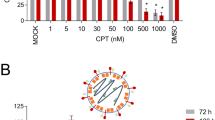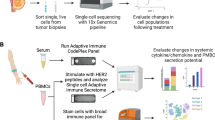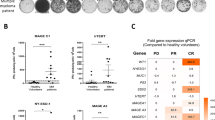Abstract
No curative therapy is currently available for locally advanced or metastatic pancreatic cancer. Therefore, new therapeutic approaches must be considered. Measles virus (MV) vaccine strains have shown promising oncolytic activity against a variety of tumor entities. For specific therapy of pancreatic cancer, we generated a fully retargeted MV that enters cells exclusively through the prostate stem cell antigen (PSCA). Besides a high-membrane frequency on prostate cancer cells, this antigen is expressed on pancreatic adenocarcinoma, but not on non-neoplastic tissue. PSCA expression levels differ within heterogeneous tumor bulks and between human pancreatic cell lines, and we could show specific infection of pancreatic adenocarcinoma cell lines with both high- and low-level PSCA expression. Furthermore, we generated a fully retargeted and armed MV-PNP-anti-PSCA to express the prodrug convertase purine nucleoside phosphorylase (PNP). PNP, which activates the prodrug fludarabine effectively, enhanced the oncolytic efficacy of the virus on infected and bystander cells. Beneficial therapeutic effects were shown in a pancreatic cancer xenograft model. Moreover, in the treatment of gemcitabine-resistant pancreatic adenocarcinoma cells, no cross-resistance to both MV oncolysis and activated prodrug was detected.
This is a preview of subscription content, access via your institution
Access options
Subscribe to this journal
Receive 12 print issues and online access
$259.00 per year
only $21.58 per issue
Buy this article
- Purchase on Springer Link
- Instant access to full article PDF
Prices may be subject to local taxes which are calculated during checkout





Similar content being viewed by others
References
Jemal A, Siegel R, Ward E, Hao Y, Xu J, Murray T et al. Cancer statistics, 2008. CA Cancer J Clin 2008; 58: 71–96.
Hidalgo M . Pancreatic cancer. N Engl J Med 2010; 362: 1605–1617.
Alberts SR, Gores GJ, Kim GP, Roberts LR, Kendrick ML, Rosen CB et al. Treatment options for hepatobiliary and pancreatic cancer. Mayo Clin Proc 2007; 82: 628–637.
Moore MJ, Goldstein D, Hamm J, Figer A, Hecht JR, Gallinger S et al. Erlotinib plus gemcitabine compared with gemcitabine alone in patients with advanced pancreatic cancer: a phase III trial of the National Cancer Institute of Canada Clinical Trials Group. J Clin Oncol 2007; 25: 1960–1966.
Vaha-Koskela MJ, Heikkila JE, Hinkkanen AE . Oncolytic viruses in cancer therapy. Cancer Lett 2007; 254: 178–216.
Blechacz B, Splinter PL, Greiner S, Myers R, Peng KW, Federspiel MJ et al. Engineered measles virus as a novel oncolytic viral therapy system for hepatocellular carcinoma. Hepatology 2006; 44: 1465–1477.
Ungerechts G, Springfeld C, Frenzke ME, Lampe J, Parker WB, Sorscher EJ et al. An immunocompetent murine model for oncolysis with an armed and targeted measles virus. Mol Ther 2007; 15: 1991–1997.
Ungerechts G, Springfeld C, Frenzke ME, Lampe J, Johnston PB, Parker WB et al. Lymphoma chemovirotherapy: CD20-targeted and convertase-armed measles virus can synergize with fludarabine. Cancer Res 2007; 67: 10939–10947.
Allen C, Paraskevakou G, Iankov I, Giannini C, Schroeder M, Sarkaria J et al. Interleukin-13 displaying retargeted oncolytic measles virus strains have significant activity against gliomas with improved specificity. Mol Ther 2008; 16: 1556–1564.
Liu C, Hasegawa K, Russell SJ, Sadelain M, Peng KW . Prostate-specific membrane antigen retargeted measles virotherapy for the treatment of prostate cancer. Prostate 2009; 69: 1128–1141.
Msaouel P, Iankov ID, Allen C, Morris JC, von Messling V, Cattaneo R et al. Engineered measles virus as a novel oncolytic therapy against prostate cancer. Prostate 2009; 69: 82–91.
Li H, Peng KW, Dingli D, Kratzke RA, Russell SJ . Oncolytic measles viruses encoding interferon beta and the thyroidal sodium iodide symporter gene for mesothelioma virotherapy. Cancer Gene Ther 2010; 17: 550–558.
Ungerechts G, Frenzke ME, Yaiw KC, Miest T, Johnston PB, Cattaneo R . Mantle cell lymphoma salvage regimen: synergy between a reprogrammed oncolytic virus and two chemotherapeutics. Gene Therapy 2010; 17: 1506–1516.
Dorig RE, Marcil A, Chopra A, Richardson CD . The human CD46 molecule is a receptor for measles virus (Edmonston strain). Cell 1993; 75: 295–305.
Naniche D, Varior-Krishnan G, Cervoni F, Wild TF, Rossi B, Rabourdin-Combe C et al. Human membrane cofactor protein (CD46) acts as a cellular receptor for measles virus. J Virol 1993; 67: 6025–6032.
Tatsuo H, Ono N, Tanaka K, Yanagi Y . SLAM (CDw150) is a cellular receptor for measles virus. Nature 2000; 406: 893–897.
Vongpunsawad S, Oezgun N, Braun W, Cattaneo R . Selectively receptor-blind measles viruses: identification of residues necessary for SLAM- or CD46-induced fusion and their localization on a new hemagglutinin structural model. J Virol 2004; 78: 302–313.
Nakamura T, Peng KW, Vongpunsawad S, Harvey M, Mizuguchi H, Hayakawa T et al. Antibody-targeted cell fusion. Nat Biotechnol 2004; 22: 331–336.
Nakamura T, Peng KW, Harvey M, Greiner S, Lorimer IA, James CD et al. Rescue and propagation of fully retargeted oncolytic measles viruses. Nat Biotechnol 2005; 23: 209–214.
Reiter RE, Gu Z, Watabe T, Thomas G, Szigeti K, Davis E et al. Prostate stem cell antigen: a cell surface marker overexpressed in prostate cancer. Proc Natl Acad Sci USA 1998; 95: 1735–1740.
Cheng L, Reiter RE, Jin Y, Sharon H, Wieder J, Lane TF et al. Immunocytochemical analysis of prostate stem cell antigen as adjunct marker for detection of urothelial transitional cell carcinoma in voided urine specimens. J Urol 2003; 169: 2094–2100.
Argani P, Rosty C, Reiter RE, Wilentz RE, Murugesan SR, Leach SD et al. Discovery of new markers of cancer through serial analysis of gene expression: prostate stem cell antigen is overexpressed in pancreatic adenocarcinoma. Cancer Res 2001; 61: 4320–4324.
Wente MN, Jain A, Kono E, Berberat PO, Giese T, Reber HA et al. Prostate stem cell antigen is a putative target for immunotherapy in pancreatic cancer. Pancreas 2005; 31: 119–125.
Hermiston TW, Kuhn I . Armed therapeutic viruses: strategies and challenges to arming oncolytic viruses with therapeutic genes. Cancer Gene Ther 2002; 9: 1022–1035.
Parker WB, Allan PW, Shaddix SC, Rose LM, Speegle HF, Gillespie GY et al. Metabolism and metabolic actions of 6-methylpurine and 2-fluoroadenine in human cells. Biochem Pharmacol 1998; 55: 1673–1681.
Morgenroth A, Cartellieri M, Schmitz M, Gunes S, Weigle B, Bachmann M et al. Targeting of tumor cells expressing the prostate stem cell antigen (PSCA) using genetically engineered T-cells. Prostate 2007; 67: 1121–1131.
Schmitt M, Pawlita M . High-throughput detection and multiplex identification of cell contaminations. Nucleic Acids Res 2009; 37: e119.
Duprex WP, McQuaid S, Hangartner L, Billeter MA, Rima BK . Observation of measles virus cell-to-cell spread in astrocytoma cells by using a green fluorescent protein-expressing recombinant virus. J Virol 1999; 73: 9568–9575.
Radecke F, Spielhofer P, Schneider H, Kaelin K, Huber M, Dotsch C et al. Rescue of measles viruses from cloned DNA. EMBO J 1995; 14: 5773–5784.
Calain P, Roux L . The rule of six, a basic feature for efficient replication of Sendai virus defective interfering RNA. J Virol 1993; 67: 4822–4830.
Angelova AL, Aprahamian M, Grekova SP, Hajri A, Leuchs B, Giese NA et al. Improvement of gemcitabine-based therapy of pancreatic carcinoma by means of oncolytic parvovirus H-1PV. Clin Cancer Res 2009; 15: 511–519.
Anderson BD, Nakamura T, Russell SJ, Peng KW . High CD46 receptor density determines preferential killing of tumor cells by oncolytic measles virus. Cancer Res 2004; 64: 4919–4926.
Phuong LK, Allen C, Peng KW, Giannini C, Greiner S, TenEyck CJ et al. Use of a vaccine strain of measles virus genetically engineered to produce carcinoembryonic antigen as a novel therapeutic agent against glioblastoma multiforme. Cancer Res 2003; 63: 2462–2469.
Peng KW, TenEyck CJ, Galanis E, Kalli KR, Hartmann LC, Russell SJ . Intraperitoneal therapy of ovarian cancer using an engineered measles virus. Cancer Res 2002; 62: 4656–4662.
McDonald CJ, Erlichman C, Ingle JN, Rosales GA, Allen C, Greiner SM et al. A measles virus vaccine strain derivative as a novel oncolytic agent against breast cancer. Breast Cancer Res Treat 2006; 99: 177–184.
Giovannetti E, Mey V, Nannizzi S, Pasqualetti G, Del Tacca M, Danesi R . Pharmacogenetics of anticancer drug sensitivity in pancreatic cancer. Mol Cancer Ther 2006; 5: 1387–1395.
Konig J, Hartel M, Nies AT, Martignoni ME, Guo J, Buchler MW et al. Expression and localization of human multidrug resistance protein (ABCC) family members in pancreatic carcinoma. Int J Cancer 2005; 115: 359–367.
Mackey JR, Mani RS, Selner M, Mowles D, Young JD, Belt JA et al. Functional nucleoside transporters are required for gemcitabine influx and manifestation of toxicity in cancer cell lines. Cancer Res 1998; 58: 4349–4357.
Dumontet C, Fabianowska-Majewska K, Mantincic D, Callet Bauchu E, Tigaud I, Gandhi V et al. Common resistance mechanisms to deoxynucleoside analogues in variants of the human erythroleukaemic line K562. Br J Haematol 1999; 106: 78–85.
McCarthy DM, Maitra A, Argani P, Rader AE, Faigel DO, Van Heek NT et al. Novel markers of pancreatic adenocarcinoma in fine-needle aspiration: mesothelin and prostate stem cell antigen labeling increases accuracy in cytologically borderline cases. Appl Immunohistochem Mol Morphol 2003; 11: 238–243.
Argani P, Iacobuzio-Donahue C, Ryu B, Rosty C, Goggins M, Wilentz RE et al. Mesothelin is overexpressed in the vast majority of ductal adenocarcinomas of the pancreas: identification of a new pancreatic cancer marker by serial analysis of gene expression (SAGE). Clin Cancer Res 2001; 7: 3862–3868.
Seo E, Abei M, Wakayama M, Fukuda K, Ugai H, Murata T et al. Effective gene therapy of biliary tract cancers by a conditionally replicative adenovirus expressing uracil phosphoribosyltransferase: significance of timing of 5-fluorouracil administration. Cancer Res 2005; 65: 546–552.
Zhang Y, Parker WB, Sorscher EJ, Ealick SE . PNP anticancer gene therapy. Curr Top Med Chem 2005; 5: 1259–1274.
Hebrard C, Dumontet C, Jordheim LP . Development of gene therapy in association with clinically used cytotoxic deoxynucleoside analogues. Cancer Gene Ther 2009; 16: 541–550.
Mohr L, Shankara S, Yoon SK, Krohne TU, Geissler M, Roberts B et al. Gene therapy of hepatocellular carcinoma in vitro and in vivo in nude mice by adenoviral transfer of the Escherichia coli purine nucleoside phosphorylase gene. Hepatology 2000; 31: 606–614.
Cai X, Zhou J, Chang Y, Sun X, Li P, Lin J . Targeting gene therapy for hepatocarcinoma cells with the E. coli purine nucleoside phosphorylase suicide gene system directed by a chimeric alpha-fetoprotein promoter. Cancer Lett 2008; 264: 71–82.
Wang XY, Martiniello-Wilks R, Shaw JM, Ho T, Coulston N, Cooke-Yarborough C et al. Preclinical evaluation of a prostate-targeted gene-directed enzyme prodrug therapy delivered by ovine atadenovirus. Gene Therapy 2004; 11: 1559–1567.
Martiniello-Wilks R, Wang XY, Voeks DJ, Dane A, Shaw JM, Mortensen E et al. Purine nucleoside phosphorylase and fludarabine phosphate gene-directed enzyme prodrug therapy suppresses primary tumour growth and pseudo-metastases in a mouse model of prostate cancer. J Gene Med 2004; 6: 1343–1357.
Kikuchi E, Menendez S, Ozu C, Ohori M, Cordon-Cardo C, Logg CR et al. Delivery of replication-competent retrovirus expressing Escherichia coli purine nucleoside phosphorylase increases the metabolism of the prodrug, fludarabine phosphate and suppresses the growth of bladder tumor xenografts. Cancer Gene Ther 2007; 14: 279–286.
Hong JS, Waud WR, Levasseur DN, Townes TM, Wen H, McPherson SA et al. Excellent in vivo bystander activity of fludarabine phosphate against human glioma xenografts that express the Escherichia coli purine nucleoside phosphorylase gene. Cancer Res 2004; 64: 6610–6615.
Lockett LJ, Molloy PL, Russell PJ, Both GW . Relative efficiency of tumor cell killing in vitro by two enzyme–prodrug systems delivered by identical adenovirus vectors. Clin Cancer Res 1997; 3: 2075–2080.
Hughes BW, Wells AH, Bebok Z, Gadi VK, Garver Jr RI, Parker WB et al. Bystander killing of melanoma cells using the human tyrosinase promoter to express the Escherichia coli purine nucleoside phosphorylase gene. Cancer Res 1995; 55: 3339–3345.
Jordheim LP, Cros E, Gouy MH, Galmarini CM, Peyrottes S, Mackey J et al. Characterization of a gemcitabine-resistant murine leukemic cell line: reversion of in vitro resistance by a mononucleotide prodrug. Clin Cancer Res 2004; 10: 5614–5621.
Acknowledgements
We thank Jessica Albert for her valuable technical assistance and Dr Zahari Raykov and Dr Jean Rommelaere (DKFZ) for providing the T3M4 and MiaPaCa-2 cells as well as Dr Stephen J Russell (Mayo Clinic) for the Vero-αHis cells. We also thank the Light Microscopy Facility at the German Cancer Research Center, including Manuela Brom and Felix Bestvater, for their technical support. This work was supported by the German Cancer Aid, Max Eder Grant No. 108307 (GU) and by the NIH Grant No. R01 CA139389 (RC).
Author information
Authors and Affiliations
Corresponding author
Ethics declarations
Competing interests
Patent applications on which RC is an inventor have been licensed to NISCO, Mayo has an equity position in NISCO; Mayo has not yet received royalties from products developed by the company, but may receive these in the future. The other authors declare no conflict of interest.
Additional information
Supplementary Information accompanies the paper on Cancer Gene Therapy website
Supplementary information
Rights and permissions
About this article
Cite this article
Bossow, S., Grossardt, C., Temme, A. et al. Armed and targeted measles virus for chemovirotherapy of pancreatic cancer. Cancer Gene Ther 18, 598–608 (2011). https://doi.org/10.1038/cgt.2011.30
Received:
Revised:
Accepted:
Published:
Issue Date:
DOI: https://doi.org/10.1038/cgt.2011.30
Keywords
This article is cited by
-
Win or loss? Combination therapy does improve the oncolytic virus therapy to pancreatic cancer
Cancer Cell International (2022)
-
Developing and validating a survival prediction model based on blood exosomal ceRNA network in patients with PAAD
BMC Medical Genomics (2022)
-
The use of Trichomonas vaginalis purine nucleoside phosphorylase to activate fludarabine in the treatment of solid tumors
Cancer Chemotherapy and Pharmacology (2020)
-
Chemovirotherapeutic Treatment Using Camptothecin Enhances Oncolytic Measles Virus-Mediated Killing of Breast Cancer Cells
Scientific Reports (2019)
-
The Role of Oncolytic Viruses in the Treatment of Melanoma
Current Oncology Reports (2018)



